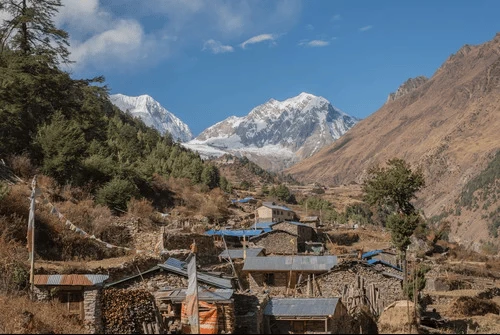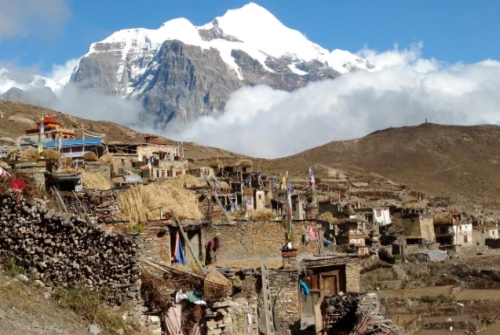Trip Overview
The Manaslu Circuit Tsum Valley Trek in Nepal is a rare and rewarding journey that combines two of the country’s most remote, culturally preserved, and less-crowded trekking routes. This epic Himalayan adventure begins in the sacred Tsum Valley, also known as the “Hidden Valley of Happiness”, home to ancient monasteries, Tibetan Buddhist traditions, and untouched mountain villages.
After exploring the spiritual heart of Tsum, trekkers reconnect with the renowned Manaslu Circuit Trek, which circles Mount Manaslu (8163m)—the eighth highest mountain in the world. The route follows the dramatic Manaslu Circuit trail, offering close-up views of Manaslu Himal, Himalchuli, and Ganesh Himal, and culminates in the challenging crossing of Larke La Pass (5106m).
This combined Manaslu Circuit Tsum Valley Trek is ideal for those seeking authentic Himalayan adventure, cultural depth, and pristine alpine landscapes. Along the way, trekkers traverse rugged terrain, glacial rivers, remote Tibetan villages, and sacred monasteries, making this one of the most spiritually and scenically rewarding treks in Nepal.
Perfect for trekkers looking for both high-altitude challenge and cultural immersion, the Manaslu Circuit Tsum Valley Trek itinerary delivers a complete and enriching journey through one of Nepal’s most protected and awe-inspiring regions.
Tsum Valley – A Spiritual Sanctuary in the Himalayas
The Tsum Valley Trek marks the beginning of this extraordinary journey, offering trekkers a profound immersion into Himalayan Tibetan Buddhist culture. Located in the Gorkha District near the Nepal-Tibet border, Tsum Valley is home to the Tsumbas, an ethnic group whose ancient traditions and lifestyle have remained remarkably preserved over centuries.
The trail passes through remote villages including Machhakhola, Jagat, Lokpa, Chumling, and Chhokangparo some of the highest permanently inhabited settlements in Nepal. Along the route, trekkers encounter spiritual landmarks such as ancient mani walls, chortens, and colorful prayer flags that vividly represent the valley’s rich Buddhist heritage.
Key cultural highlights of the Manaslu Tsum Valley Trek include visits to Mu Gompa Monastery (3700m) one of the oldest monasteries believed to be founded by Guru Rinpoche and Rachen Gompa, a nunnery providing rare insight into Tibetan Buddhist practices.
This part of the manaslu tsum valley trek map offers not just stunning mountain scenery but also a deeply enriching cultural experience. Trekkers will witness traditional yak herding, highland barley farming, and daily monastic rituals, making the Tsum Valley trek both physically demanding and spiritually rewarding.
Manaslu Circuit – The Ultimate Himalayan Adventure
After completing the Tsum Valley section, trekkers rejoin the Manaslu Circuit Trek route at Deng, ascending through picturesque villages such as Shyala, Lho, Samagaon, and Samdo. According to the manaslu trek map, this trail offers breathtaking Himalayan panoramas, including views of Himalchuli, Ngadi Chuli, Ganesh Himal, and the majestic Mt. Manaslu itself.
The village of Samagaon (3530m) is a crucial acclimatization stop in most manaslu circuit trek itineraries. Here, trekkers can choose to hike to Manaslu Base Camp (4400m), a challenging yet rewarding side trip, or enjoy a gentler walk to Birendra Lake, a stunning turquoise glacial lake nestled beneath the Manaslu glacier.
From Samdo (3860m), there is an optional high-altitude hike to Rui La Pass (4998m) near the Nepal-Tibet border. This trek helps with acclimatization and prepares trekkers for the demanding Larke La Pass crossing.
Crossing Larke Pass is the highlight of the manaslu circuit trek, offering spectacular views of Cheo Himal, Himlung Himal, and distant peaks of the Annapurna range. After descending from the pass, the trek concludes as you enter the Marsyangdi Valley, finishing at Bhimthang or Dharapani, where the Annapurna Conservation Area Permit (ACAP) is required.
Acclimatization and Altitude Safety on the Manaslu Circuit Tsum Valley Trek
The Manaslu Circuit and Tsum Valley Trek reaches high altitudes above 5000 meters, making proper acclimatization essential for a safe and successful journey. The manaslu circuit trekking itinerary thoughtfully includes three key acclimatization rest days to help your body adjust to the thin mountain air and reduce the risk of altitude sickness.
Nile (3361m): Trekkers take a day hike to Mu Gompa (3700m), the oldest monastery in Tsum Valley, providing both cultural insight and vital acclimatization benefits.
Samagaon (3530m): This important stop offers optional hikes to Manaslu Base Camp (4400m) or a more relaxed walk to the scenic Birendra Lake, helping trekkers gradually prepare for higher elevations.
Samdo (3860m): A final altitude training hike to Rui La Pass (4998m) near the Nepal-Tibet border boosts your acclimatization before the challenging Larke La Pass crossing.
Following the proven principle of "climb high, sleep low," these acclimatization days significantly increase your chances of completing the larke pass manaslu trek safely and comfortably, minimizing symptoms of acute mountain sickness (AMS).
Permits Required for Tsum Valley Manaslu Circuit Trek
Trekking in the Manaslu and Tsum Valley region requires several permits due to its restricted status. The most important is the Restricted Area Permit (RAP), which is mandatory for both the Manaslu Circuit and Tsum Valley sections. This permit can only be obtained through a registered trekking agency and is priced based on the number of days spent in the restricted area and the season.
In addition to the RAP, you also need the Manaslu Conservation Area Permit (MCAP), which is required for entering the Manaslu Conservation Area. If your itinerary ends by crossing Larke Pass and exiting through Dharapani into the Annapurna region, then you must also obtain the Annapurna Conservation Area Permit (ACAP).
Solo trekking is strictly prohibited in this region. As per the rules set by the Government of Nepal, you must be in a group of at least two trekkers (not including the guide) and be accompanied by a licensed guide or porter-guide. These regulations are in place for both safety and environmental conservation.All permits must be arranged before the trek and are issued only through a government-authorized trekking agency in Nepal.
Best Time for Tsum Valley Manaslu Circuit Trek
The ideal time to embark on the Tsum Valley and Manaslu Circuit Trek is during the autumn (September to November) and spring (March to May) seasons. These months offer the most stable weather, with clear skies, excellent mountain views, and pleasant temperatures, especially at lower and mid-altitudes.
In spring, the trails come alive with blooming wildflowers and rhododendrons, adding vibrant color to the landscape. In autumn, major festivals like Dashain, Tihar, and Lhosar enhance the cultural experience as you pass through remote villages rich in tradition.These seasons also bring lower risks of landslides, heavy snowfall, or trail closures, making the trek safer and more enjoyable.
On the other hand, the monsoon season (June to August) is not recommended due to heavy rainfall, leeches, muddy trails, and potential floods. Similarly, winter (December to February) brings extreme cold, deep snow at higher passes like Larke La, and the closure of many teahouses, making trekking more difficult and less comfortable.For the best combination of scenic beauty, cultural encounters, and trekking safety, plan your journey in autumn or spring.
Why Choose All Nepal Hiking for Your Manaslu Tsum Valley Trek
With over a decade of experience,All Nepal Hiking Pvt. Ltd. is a reliable and locally owned trekking company, specializing in customized trekking packages in the Manaslu, Everest, Annapurna, and Langtang regions.
Our team consists of certified guides and local Sherpas who are natives of the Gorkha and Manaslu region, offering unmatched local knowledge, affordable trek packages, and an emphasis on eco-friendly trekking practices. We prioritize customer safety, cultural integrity, and sustainable tourism over commercial gain.
We take pride in our high success rate, transparent communication, and ethical operation standards. With All Nepal Hiking , you don’t just trek, you connect with the land, the people, and the spiritual essence of the Himalayas.


 based on 6 reviews
based on 6 reviews
